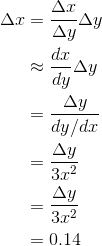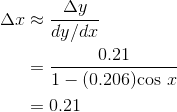In the 1958 science fiction novel Have Space Suit - Will Travel, by Robert Heinlein, Kip is a high school student who wants to be an engineer, and his father is trying to convince him to stretch himself more if he wants to get any- thing out of his education:
“Why did Van Buren fail of re- election? How do you extract the cube root of eighty-seven?”
Van Buren had been a president; that was all I remembered. But I
could answer the other one. “If you want a cube root, you look in a table in the back of the book.”
Dad sighed. “Kip, do you think that table was brought down from on high by an archangel?”
We no longer use tables to compute roots, but how does a pocket calculator do it? A technique called Newton’s method allows us to calculate the inverse of any function efficiently, including
cases that aren’t preprogrammed into a calculator. In the example from the novel, we know how to calculate the function  fairly accurately and quickly for any given value of
fairly accurately and quickly for any given value of  , but we want to turn the equation around and find
, but we want to turn the equation around and find  when
when
 . We start with a rough mental guess: since
. We start with a rough mental guess: since  is a little too small, and
is a little too small, and  is much too big, we guess
is much too big, we guess  . Testing our guess, we have
. Testing our guess, we have  . We want
. We want  to get bigger by 7.5, and we can use calculus to find approximately how much bigger
to get bigger by 7.5, and we can use calculus to find approximately how much bigger  needs to get in order to accomplish that:
needs to get in order to accomplish that:

Increasing our value of  to 4.3 +0.14 = 4.44, we find that
to 4.3 +0.14 = 4.44, we find that  =87.5 is a pretty good approximation to 87. If we need higher precision, we can go
through the process again with
=87.5 is a pretty good approximation to 87. If we need higher precision, we can go
through the process again with  , giving
, giving

This second iteration gives an excellent approximation.
Example

Figure 5.1 shows the astronomer Johannes Kepler’s analysis
of the motion of the planets. The ellipse is the orbit of the planet around the sun. At  , the planet is at its closest approach to the sun, A. At some later time, the planet is at point B. The angle x (measured in
radians) is defined with reference to the imaginary circle encompassing the orbit. Kepler found the equation
, the planet is at its closest approach to the sun, A. At some later time, the planet is at point B. The angle x (measured in
radians) is defined with reference to the imaginary circle encompassing the orbit. Kepler found the equation

where the period,  , is the time required for the planet to complete
a full orbit, and the eccentricity of the ellipse,
, is the time required for the planet to complete
a full orbit, and the eccentricity of the ellipse,  , is a number
that measures how much it differs from a circle. The relationship is complicated because the planet speeds up as it falls inward toward the sun, and slows down again as it swings back away
from it.
, is a number
that measures how much it differs from a circle. The relationship is complicated because the planet speeds up as it falls inward toward the sun, and slows down again as it swings back away
from it.
The planet Mercury has  . Find the angle
. Find the angle  when Mercury has completed 1/4 of a period.
when Mercury has completed 1/4 of a period.
We have

and we want to find  when
when  . As a first guess, we try
. As a first guess, we try  (90 degrees), since the eccentricity of Mercury’s orbit is actually much smaller than the example shown in the figure, and
therefore the planet’s speed doesn’t vary all that much as it goes around the sun. For this value of
(90 degrees), since the eccentricity of Mercury’s orbit is actually much smaller than the example shown in the figure, and
therefore the planet’s speed doesn’t vary all that much as it goes around the sun. For this value of  we have
we have  , which is too small by 0.21.
, which is too small by 0.21.

(The derivative  happens to be 1 at
happens to be 1 at  .) This gives a new value of
.) This gives a new value of  ,
1.57+.21=1.78. Testing it, we have
,
1.57+.21=1.78. Testing it, we have  , which is correct to within
rounding errors after only one iteration. (We were only supplied with a value of e accurate to three significant figures, so we can’t get a result with precision better than about that
level.)
, which is correct to within
rounding errors after only one iteration. (We were only supplied with a value of e accurate to three significant figures, so we can’t get a result with precision better than about that
level.)
- 3165 reads






